【STM32】RCC时钟模块(使用HAL库)
https://gitee.com/linhir-linhir/stm32-f103-c8/blob/master/STM32%E6%9C%80%E6%96%B0%E5%9B%BA%E4%BB%B6%E5%BA%93v3.5/Libraries/STM32F10x_StdPeriph_Driver/inc/stm32f10x_rcc.h
STM32最新固件库v3.5/Libraries/CMSIS/CM3/DeviceSupport/ST/STM32F10x/system_stm32f10x.c · 林何/STM32F103C8 - 码云 - 开源中国 (gitee.com)
1.宏定义
1.宏定义的位置
如果这个宏定义只能在.c文件中使用,则应该在.c文件中定义
如果这个宏定义既可以在.c或者.h文件中使用,则应该在.h中定义
2.位带:RCC_OFFSET
因为我们STM32是32位的寄存器,所以如果我们只想要操作寄存器其中的一位,所以我们可以使用位移操作
/* ------------ RCC registers bit address in the alias region ----------- */
/*RCC_OFFSET:等价于RCC的基地址和外设寄存器之差
*/
/*!< PERIPH_BAS--》 Peripheral base address in the alias region */#define RCC_OFFSET (RCC_BASE - PERIPH_BASE)3.第一个寄存器:CR
1.HSION
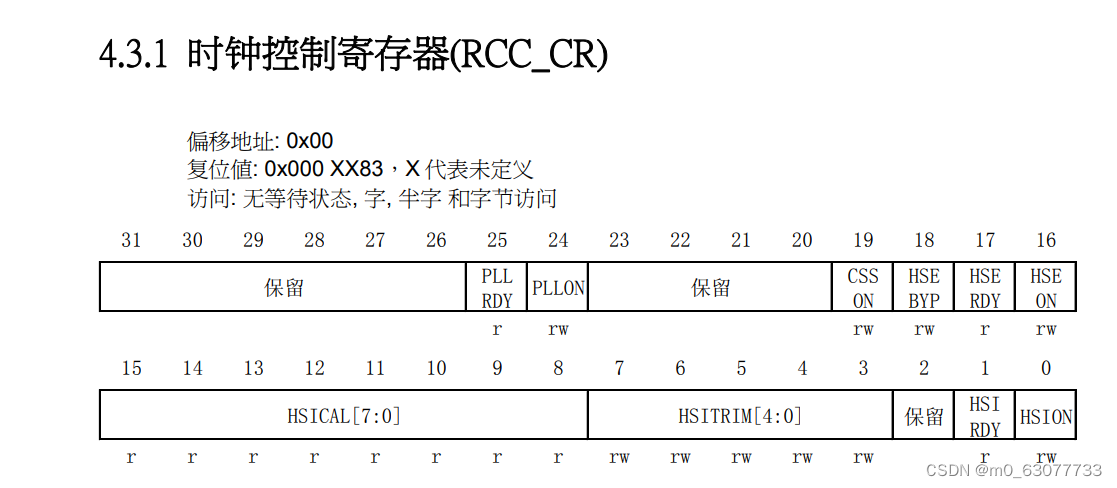
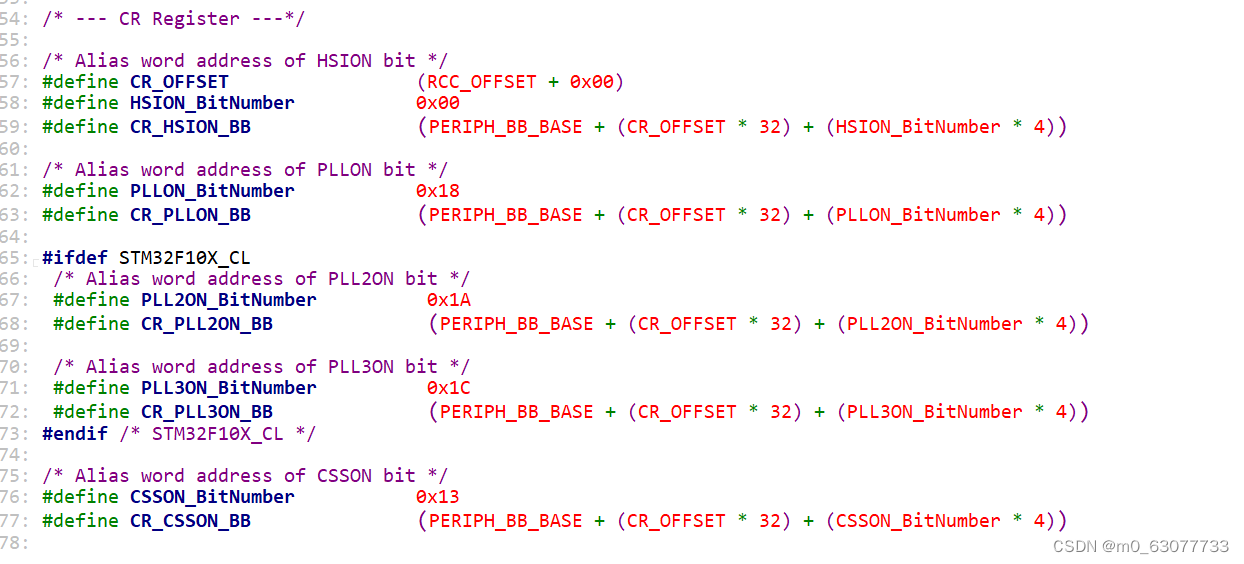
/* --- CR Register ---*//* Alias word address of HSION bit */
//这个寄存器相对于基地址的位置
#define CR_OFFSET (RCC_OFFSET + 0x00)
//操作HSION这一位相对于整个CR寄存器的偏移量
#define HSION_BitNumber 0x00
//CR寄存器中的HSION中的位带
//PERIPH_BB_BASE:位带访问区的基地址
#define CR_HSION_BB (PERIPH_BB_BASE + (CR_OFFSET * 32) + (HSION_BitNumber * 4))
如果想要对其进行设置,就直接给CR_HSION_BB赋值
2.PLLON
/* Alias word address of PLLON bit */
#define PLLON_BitNumber 0x18
#define CR_PLLON_BB (PERIPH_BB_BASE + (CR_OFFSET * 32) + (PLLON_BitNumber * 4))4.RCC registers bit mask
Reset:进行位与置0
Set:进行位或置1
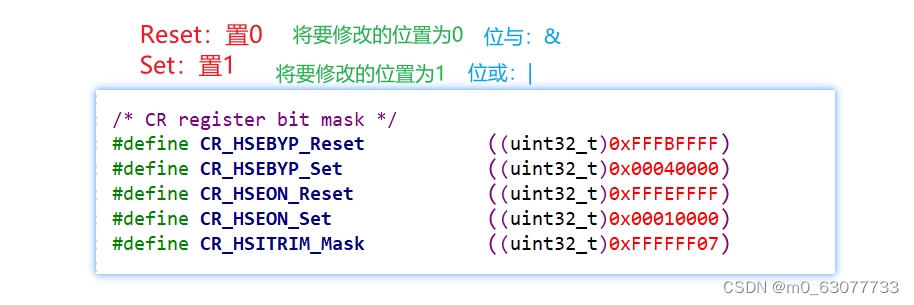
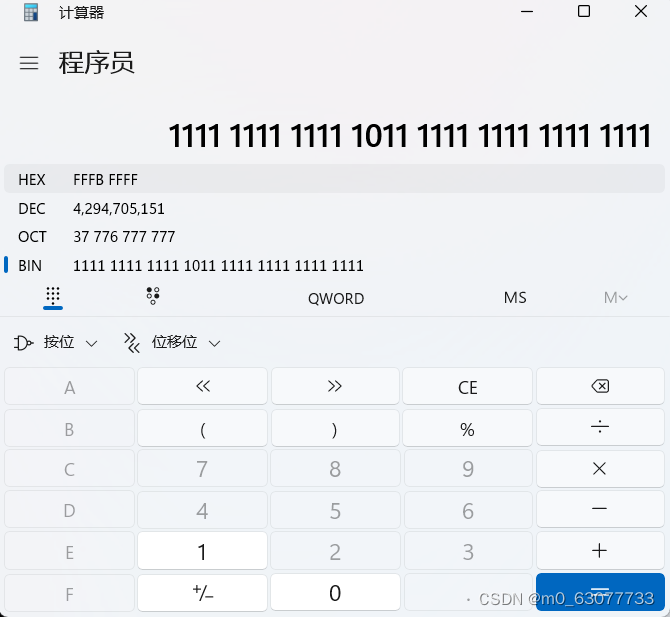
/* ---------------------- RCC registers bit mask ------------------------ *//* CR register bit mask */
#define CR_HSEBYP_Reset ((uint32_t)0xFFFBFFFF)
#define CR_HSEBYP_Set ((uint32_t)0x00040000)
#define CR_HSEON_Reset ((uint32_t)0xFFFEFFFF)
#define CR_HSEON_Set ((uint32_t)0x00010000)
#define CR_HSITRIM_Mask ((uint32_t)0xFFFFFF07)
2.全局变量
定义了预分配处理器
1.static
c语言中static关键字用法详解_static在c语言中的用法-CSDN博客
2.volatile
这个变量跟某一个寄存器的值进行绑定,寄存器里面有一个值是硬件可以改动的值
C语言丨深入理解volatile关键字-腾讯云开发者社区-腾讯云 (tencent.com)
3.uint
uint8:表示unsigned short
uint16:表示unsigned char
uint32:表示unsigned int
static __I uint8_t APBAHBPrescTable[16] = {0, 0, 0, 0, 1, 2, 3, 4, 1, 2, 3, 4, 6, 7, 8, 9};
static __I uint8_t ADCPrescTable[4] = {2, 4, 6, 8};3.函数
1.RCC_DeInit
/*** @brief Resets the RCC clock configuration to the default reset state.* @param None* @retval None*/
void RCC_DeInit(void)
{/* Set HSION bit */
//将CR这个位写为1RCC->CR |= (uint32_t)0x00000001;/* Reset SW, HPRE, PPRE1, PPRE2, ADCPRE and MCO bits */
#ifndef STM32F10X_CLRCC->CFGR &= (uint32_t)0xF8FF0000;
#else//非CL的芯片使用RCC->CFGR &= (uint32_t)0xF0FF0000;
#endif /* STM32F10X_CL */ /* Reset HSEON, CSSON and PLLON bits */
//HSEON, CSSON and PLLON:将这几位置0RCC->CR &= (uint32_t)0xFEF6FFFF;/* Reset HSEBYP bit */RCC->CR &= (uint32_t)0xFFFBFFFF;/* Reset PLLSRC, PLLXTPRE, PLLMUL and USBPRE/OTGFSPRE bits */RCC->CFGR &= (uint32_t)0xFF80FFFF;#ifdef STM32F10X_CL/* Reset PLL2ON and PLL3ON bits */RCC->CR &= (uint32_t)0xEBFFFFFF;/* Disable all interrupts and clear pending bits */RCC->CIR = 0x00FF0000;/* Reset CFGR2 register */RCC->CFGR2 = 0x00000000;
#elif defined (STM32F10X_LD_VL) || defined (STM32F10X_MD_VL) || defined (STM32F10X_HD_VL)/* Disable all interrupts and clear pending bits */RCC->CIR = 0x009F0000;/* Reset CFGR2 register */RCC->CFGR2 = 0x00000000;
#else/* Disable all interrupts and clear pending bits */RCC->CIR = 0x009F0000;
#endif /* STM32F10X_CL */}2.RCC_HSEConfig
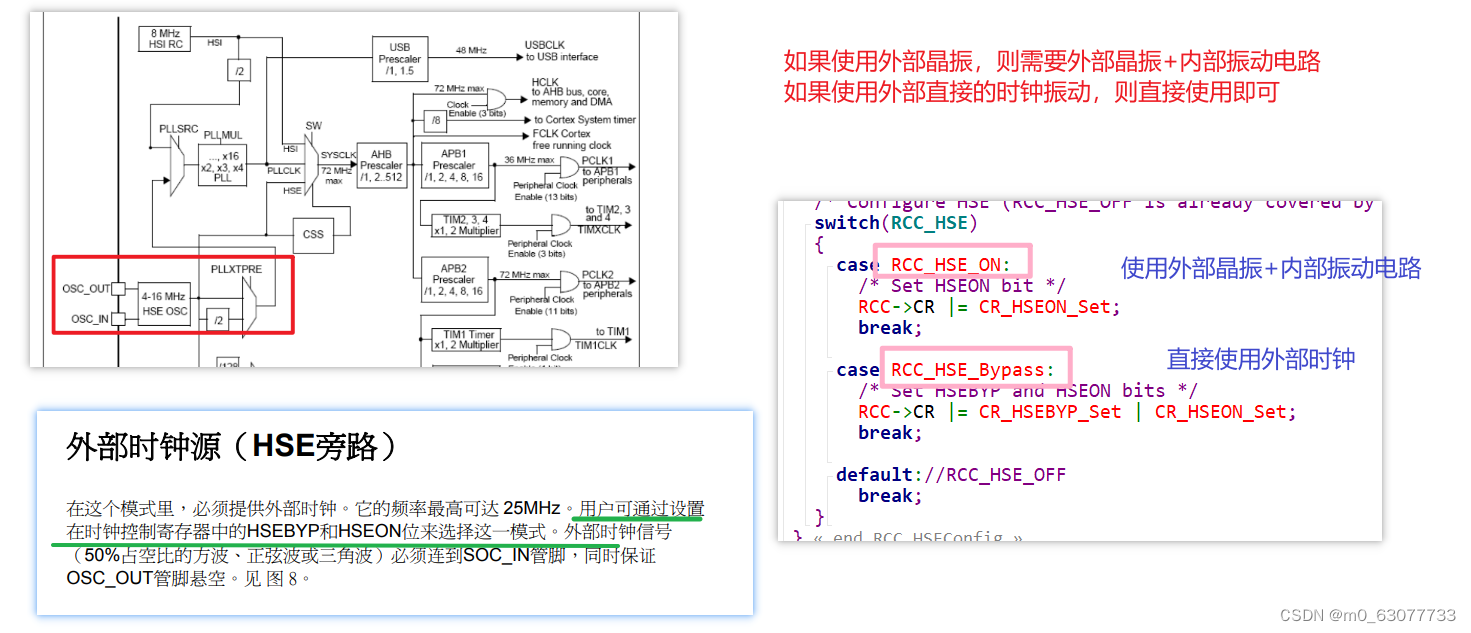
可以关闭时钟,所以平时我们不操纵它
这个HSEConfig实际效果:控制CPU是使用
外部晶振+内部振动电路 VS 外部时钟
1.assert:断言
assert机制是c语言用来判断一个东西是对的还是错的,如果是对的直接忽略过去,如果是错的就以某一种方式告诉我们(warrning error)让我们去修改。
/* Exported macro ------------------------------------------------------------*/
#ifdef USE_FULL_ASSERT
/*** @brief The assert_param macro is used for function's parameters check.* @param expr: If expr is false, it calls assert_failed function which reports * the name of the source file and the source line number of the call * that failed. If expr is true, it returns no value.* @retval None*/#define assert_param(expr) ((expr) ? (void)0 : assert_failed((uint8_t *)__FILE__, __LINE__))
/* Exported functions ------------------------------------------------------- */void assert_failed(uint8_t* file, uint32_t line);
#else#define assert_param(expr) ((void)0)
#endif /* USE_FULL_ASSERT */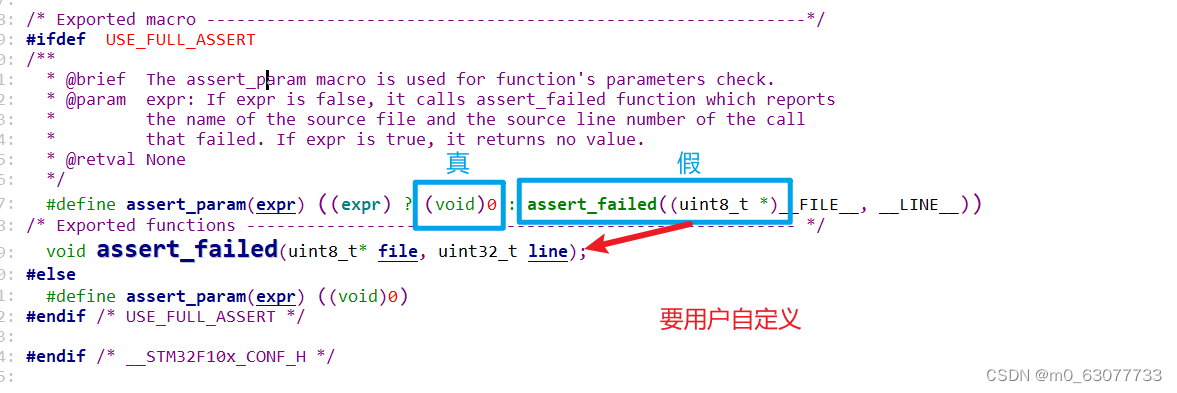
这个函数要用户自己去实现
void assert_failed(uint8_t* file, uint32_t line)
{ /* User can add his own implementation to report the file name and line number,ex: printf("Wrong parameters value: file %s on line %d\r\n", file, line) *//* Infinite loop *///用户用自己的方法去报错一个断言错误//用户可以用#error灯方法来在编译时报错(前提是断言表达式必须在预处理时就能有结果)//更常见的方式是用户在运行时报错,用printf打印调试信息//while (1){}
}2.判断用户输入的参数是否正确
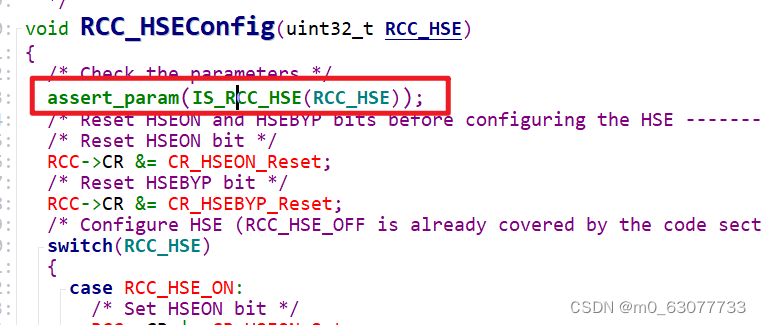

3.代码理解
/*** @brief Configures the External High Speed oscillator (HSE).* @note HSE can not be stopped if it is used directly or through the PLL as system clock.* @param RCC_HSE: specifies the new state of the HSE.* This parameter can be one of the following values:* @arg RCC_HSE_OFF: HSE oscillator OFF* @arg RCC_HSE_ON: HSE oscillator ON* @arg RCC_HSE_Bypass: HSE oscillator bypassed with external clock* @retval None*/
void RCC_HSEConfig(uint32_t RCC_HSE)
{/* Check the parameters */assert_param(IS_RCC_HSE(RCC_HSE));/* Reset HSEON and HSEBYP bits before configuring the HSE ------------------*//* Reset HSEON bit */RCC->CR &= CR_HSEON_Reset;/* Reset HSEBYP bit */RCC->CR &= CR_HSEBYP_Reset;/* Configure HSE (RCC_HSE_OFF is already covered by the code section above) */switch(RCC_HSE){case RCC_HSE_ON:/* Set HSEON bit */RCC->CR |= CR_HSEON_Set;break;case RCC_HSE_Bypass:/* Set HSEBYP and HSEON bits */RCC->CR |= CR_HSEBYP_Set | CR_HSEON_Set;break;default://RCC_HSE_OFFbreak;}
}3.RCC_WaitForHSEStartUp(等待HSE)
1.ErrorStatus
判断是否成功
一般:0:表示失败
1:表示成功
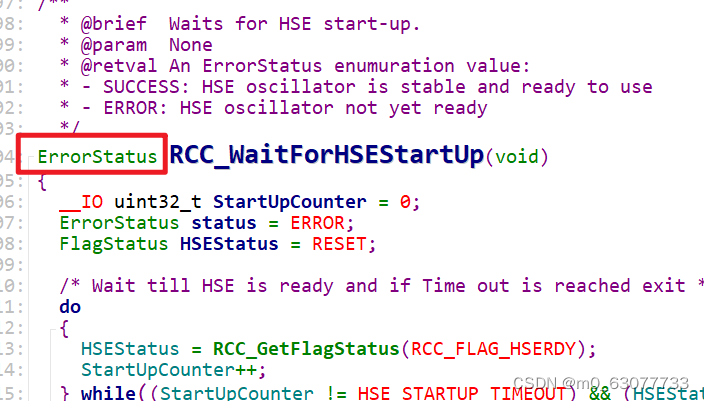
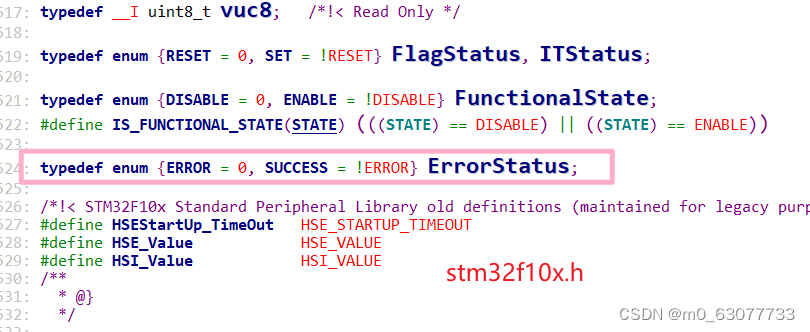
2.计数值加上volatile
因为这个变量是我们来进行判断是否超时的局部变量,所以每当我们调用这个函数的时候,应该将这个计数值清0,所以这里才使用

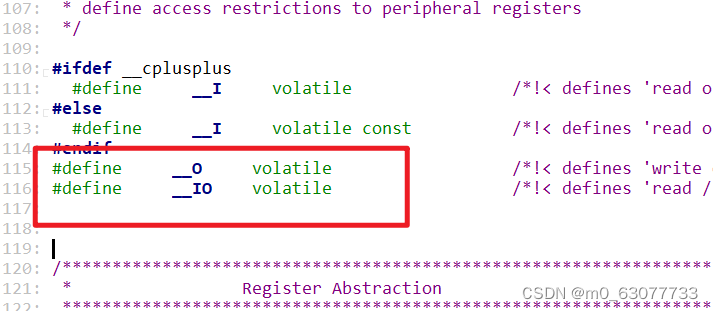
3.代码理解
/*** @brief Waits for HSE start-up.* @param None* @retval An ErrorStatus enumuration value:* - SUCCESS: HSE oscillator is stable and ready to use* - ERROR: HSE oscillator not yet ready*/
ErrorStatus RCC_WaitForHSEStartUp(void)
{__IO uint32_t StartUpCounter = 0;ErrorStatus status = ERROR;FlagStatus HSEStatus = RESET;/* Wait till HSE is ready and if Time out is reached exit */do{//读取寄存器的值HSEStatus = RCC_GetFlagStatus(RCC_FLAG_HSERDY);StartUpCounter++; //读取是否超时的} while((StartUpCounter != HSE_STARTUP_TIMEOUT) && (HSEStatus == RESET));//这里判断是防止超时if (RCC_GetFlagStatus(RCC_FLAG_HSERDY) != RESET){status = SUCCESS;}else{//超时status = ERROR;} return (status);
}4.RCC_GetFlagStatus(获取bit位状态)
1)确定这个RCC-FLAG在哪一个寄存器上
2)确定这个RCC_FLAG在寄存器是哪一个位上
1.返回值进行状态判断

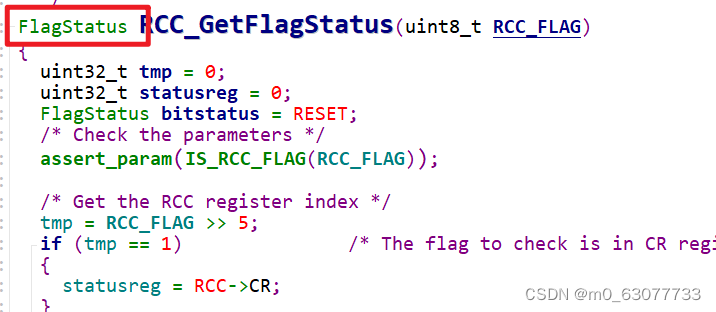
2.输入参数
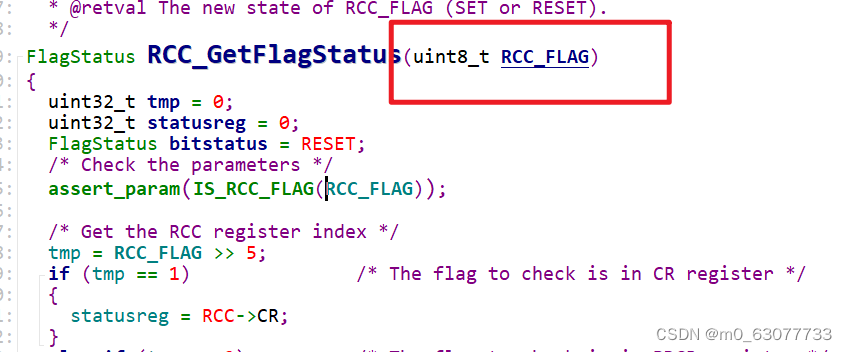
3.IS_RCC_FLAG
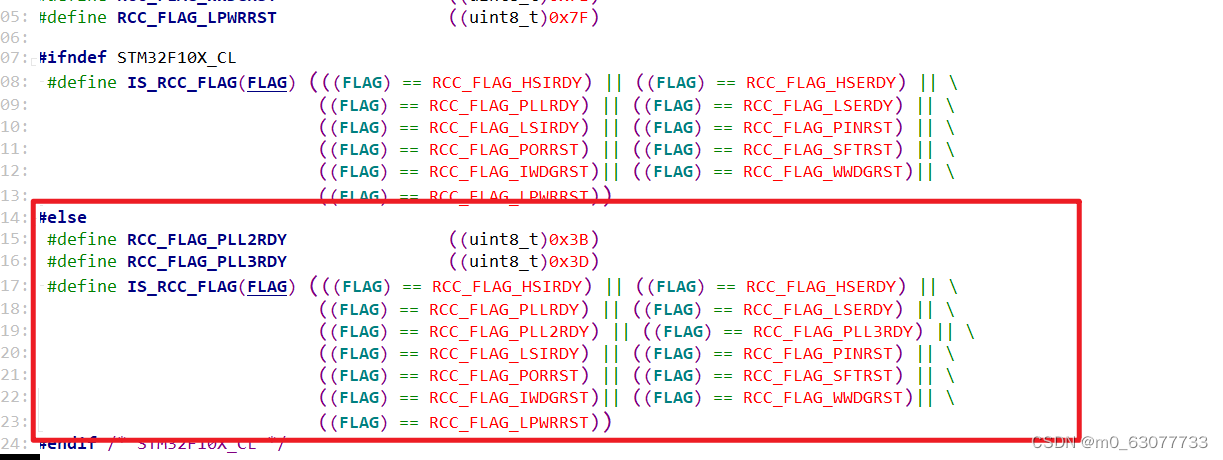
4.判断当前是在哪一个寄存器中
右移5位是想要判断第5位是1还是2还是3,然后进行判断是哪一个寄存器
/* Get the RCC register index *///将输入的标志位右移5位tmp = RCC_FLAG >> 5;//判断要访问哪一个寄存器if (tmp == 1) /* The flag to check is in CR register */{statusreg = RCC->CR;}else if (tmp == 2) /* The flag to check is in BDCR register */{statusreg = RCC->BDCR;}else /* The flag to check is in CSR register */{statusreg = RCC->CSR;}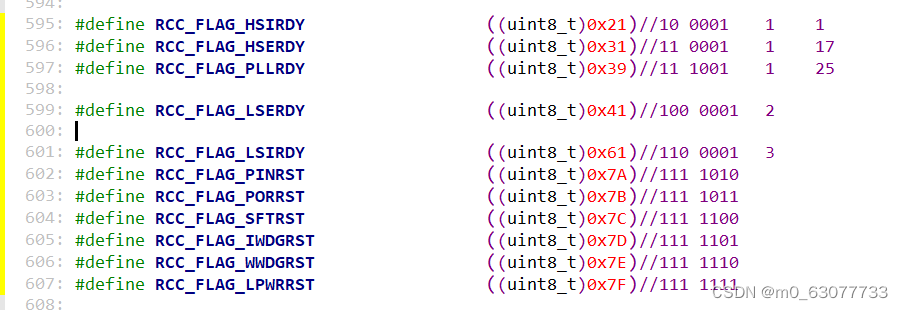
5.判断在寄存器的哪一个位上
/* Get the flag position *//**FLAG_Mask:0x1f*/tmp = RCC_FLAG & FLAG_Mask;if ((statusreg & ((uint32_t)1 << tmp)) != (uint32_t)RESET){bitstatus = SET;}else{bitstatus = RESET;}6.代码理解
/*** @brief Checks whether the specified RCC flag is set or not.* @param RCC_FLAG: specifies the flag to check.* * For @b STM32_Connectivity_line_devices, this parameter can be one of the* following values:* @arg RCC_FLAG_HSIRDY: HSI oscillator clock ready* @arg RCC_FLAG_HSERDY: HSE oscillator clock ready* @arg RCC_FLAG_PLLRDY: PLL clock ready* @arg RCC_FLAG_PLL2RDY: PLL2 clock ready * @arg RCC_FLAG_PLL3RDY: PLL3 clock ready * @arg RCC_FLAG_LSERDY: LSE oscillator clock ready* @arg RCC_FLAG_LSIRDY: LSI oscillator clock ready* @arg RCC_FLAG_PINRST: Pin reset* @arg RCC_FLAG_PORRST: POR/PDR reset* @arg RCC_FLAG_SFTRST: Software reset* @arg RCC_FLAG_IWDGRST: Independent Watchdog reset* @arg RCC_FLAG_WWDGRST: Window Watchdog reset* @arg RCC_FLAG_LPWRRST: Low Power reset* * For @b other_STM32_devices, this parameter can be one of the following values: * @arg RCC_FLAG_HSIRDY: HSI oscillator clock ready* @arg RCC_FLAG_HSERDY: HSE oscillator clock ready* @arg RCC_FLAG_PLLRDY: PLL clock ready* @arg RCC_FLAG_LSERDY: LSE oscillator clock ready* @arg RCC_FLAG_LSIRDY: LSI oscillator clock ready* @arg RCC_FLAG_PINRST: Pin reset* @arg RCC_FLAG_PORRST: POR/PDR reset* @arg RCC_FLAG_SFTRST: Software reset* @arg RCC_FLAG_IWDGRST: Independent Watchdog reset* @arg RCC_FLAG_WWDGRST: Window Watchdog reset* @arg RCC_FLAG_LPWRRST: Low Power reset* * @retval The new state of RCC_FLAG (SET or RESET).*/
FlagStatus RCC_GetFlagStatus(uint8_t RCC_FLAG)
{uint32_t tmp = 0;uint32_t statusreg = 0;FlagStatus bitstatus = RESET;/* Check the parameters */assert_param(IS_RCC_FLAG(RCC_FLAG));/* Get the RCC register index *///将输入的标志位右移5位tmp = RCC_FLAG >> 5;//判断要访问哪一个寄存器if (tmp == 1) /* The flag to check is in CR register */{statusreg = RCC->CR;}else if (tmp == 2) /* The flag to check is in BDCR register */{statusreg = RCC->BDCR;}else /* The flag to check is in CSR register */{statusreg = RCC->CSR;}/* Get the flag position *//**FLAG_Mask:0x1f:1 1111*///这里我们可以得出应该将“1”移动几个bit//比如我们此时选中的RCC_FLAG=RCC->CR的HSERDY(此位对应bit17)//则此时tmp=11 0001 & 1 1111=1 0001(对应十进制17) tmp = RCC_FLAG & FLAG_Mask;//RESET表示置位:表示数值“0”if ((statusreg & ((uint32_t)1 << tmp)) != (uint32_t)RESET){//此时进入,表示该位已经被设置为1bitstatus = SET;}else{bitstatus = RESET;}/* Return the flag status */return bitstatus;
}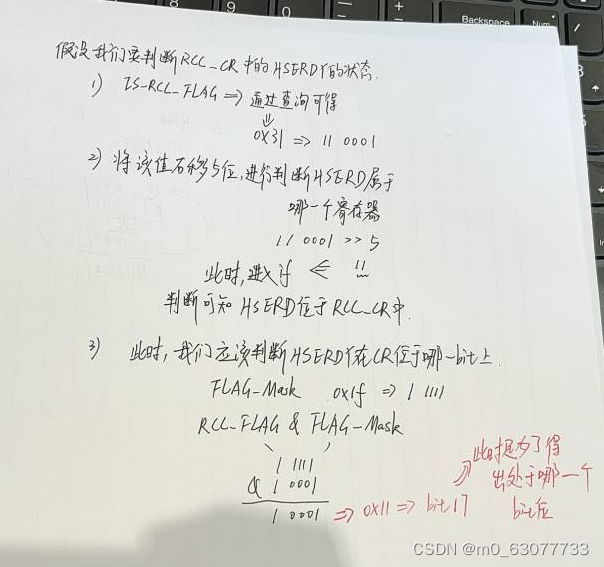
5.RCC_HSICmd(设置内部晶振状态)
发送命令的
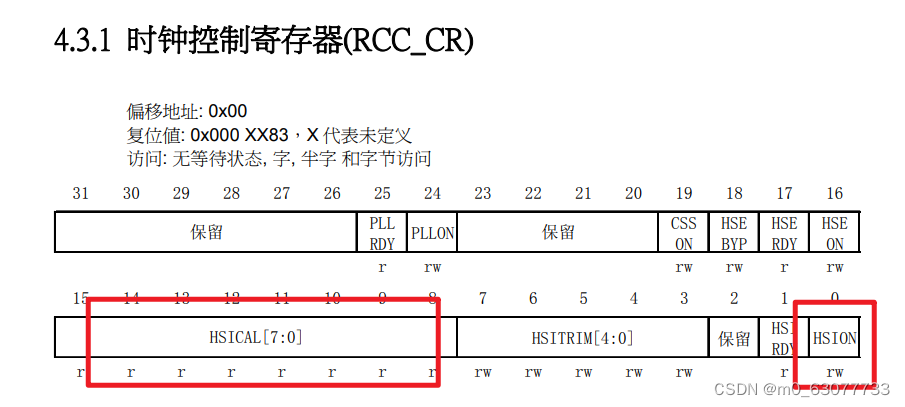
/*** @brief Enables or disables the Internal High Speed oscillator (HSI).* @note HSI can not be stopped if it is used directly or through the PLL as system clock.* @param NewState: new state of the HSI. This parameter can be: ENABLE or DISABLE.* @retval None*/
void RCC_HSICmd(FunctionalState NewState)
{/* Check the parameters */assert_param(IS_FUNCTIONAL_STATE(NewState));*(__IO uint32_t *) CR_HSION_BB = (uint32_t)NewState;
}这里使用解引用的方式,因为我们这里只需要操纵一位
6.RCC_PLLConfig(设置时钟频率)
在使用这个PLL之前一定一定是没有使用PLL,才可以调用这个函数
配置PLL的时钟源倍频
1.参数:时钟倍频
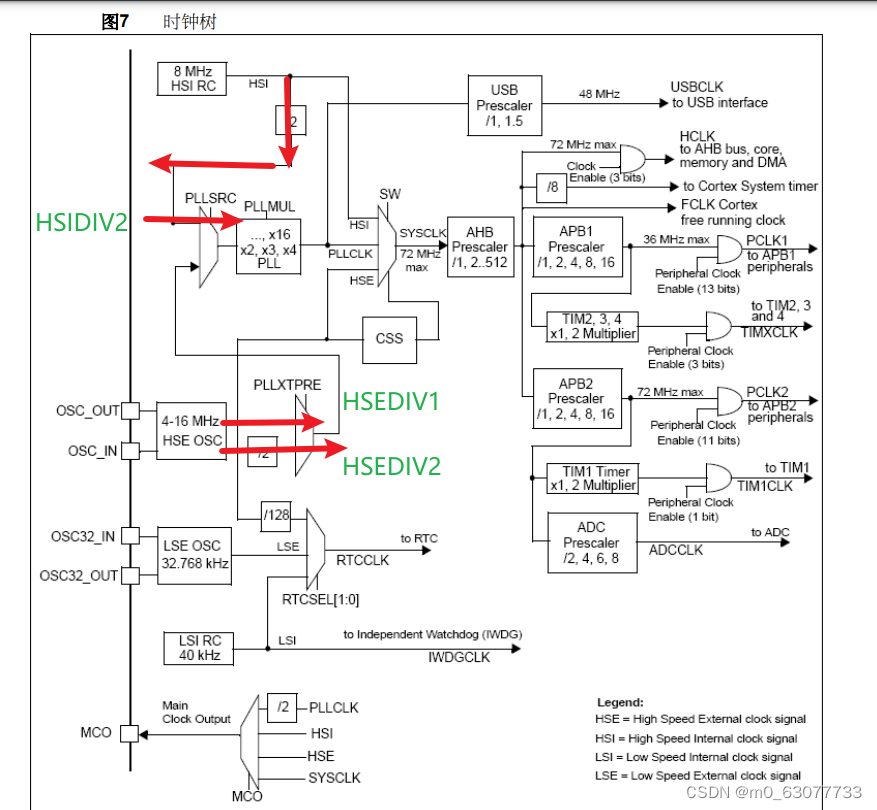

2.参数:时钟PLL倍频系数
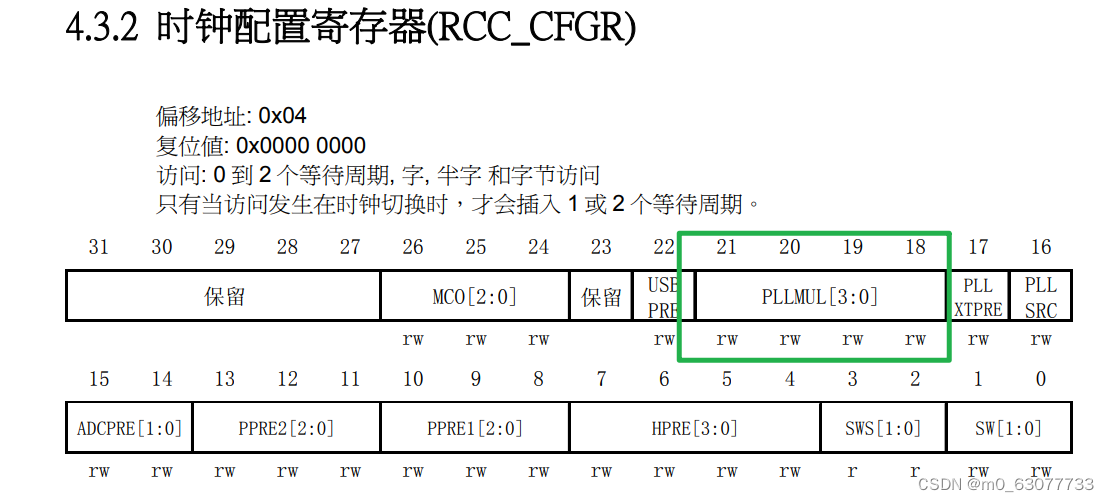

3.代码理解
/*** @brief Configures the PLL clock source and multiplication factor.* @note This function must be used only when the PLL is disabled.* @param RCC_PLLSource: specifies the PLL entry clock source.* For @b STM32_Connectivity_line_devices or @b STM32_Value_line_devices, * this parameter can be one of the following values:* @arg RCC_PLLSource_HSI_Div2: HSI oscillator clock divided by 2 selected as PLL clock entry* @arg RCC_PLLSource_PREDIV1: PREDIV1 clock selected as PLL clock entry* For @b other_STM32_devices, this parameter can be one of the following values:* @arg RCC_PLLSource_HSI_Div2: HSI oscillator clock divided by 2 selected as PLL clock entry* @arg RCC_PLLSource_HSE_Div1: HSE oscillator clock selected as PLL clock entry* @arg RCC_PLLSource_HSE_Div2: HSE oscillator clock divided by 2 selected as PLL clock entry * @param RCC_PLLMul: specifies the PLL multiplication factor.* For @b STM32_Connectivity_line_devices, this parameter can be RCC_PLLMul_x where x:{[4,9], 6_5}* For @b other_STM32_devices, this parameter can be RCC_PLLMul_x where x:[2,16] * @retval None*/
void RCC_PLLConfig(uint32_t RCC_PLLSource, uint32_t RCC_PLLMul)
{uint32_t tmpreg = 0;/* Check the parameters */assert_param(IS_RCC_PLL_SOURCE(RCC_PLLSource));assert_param(IS_RCC_PLL_MUL(RCC_PLLMul));tmpreg = RCC->CFGR;//我们要操纵的2个参数都在CFGR/* Clear PLLSRC, PLLXTPRE and PLLMUL[3:0] bits */tmpreg &= CFGR_PLL_Mask;//清零/* Set the PLL configuration bits */tmpreg |= RCC_PLLSource | RCC_PLLMul;//置1/* Store the new value */RCC->CFGR = tmpreg;
}7.RCC_PREDIV1Config(与F1无关,此处不看)
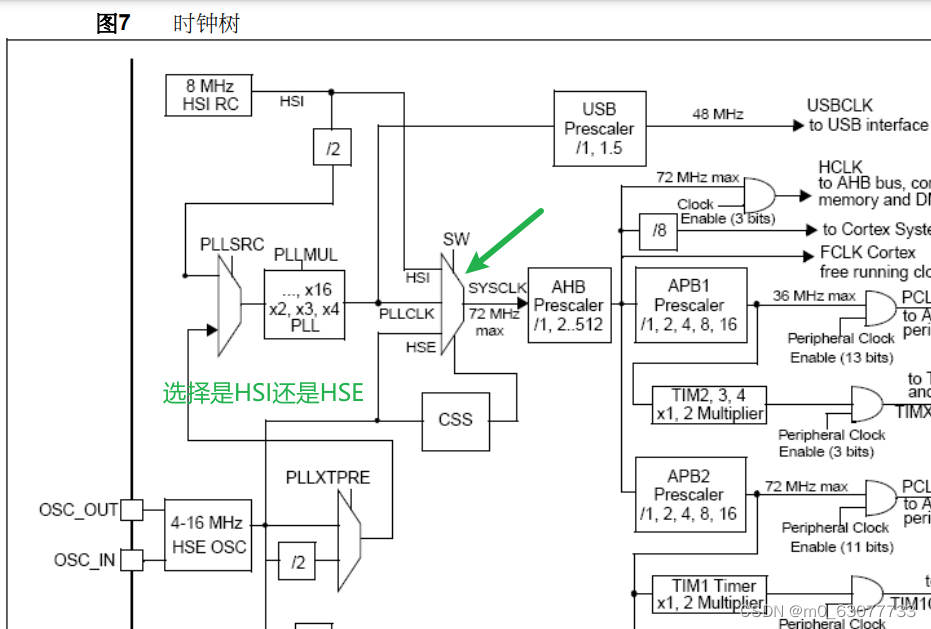
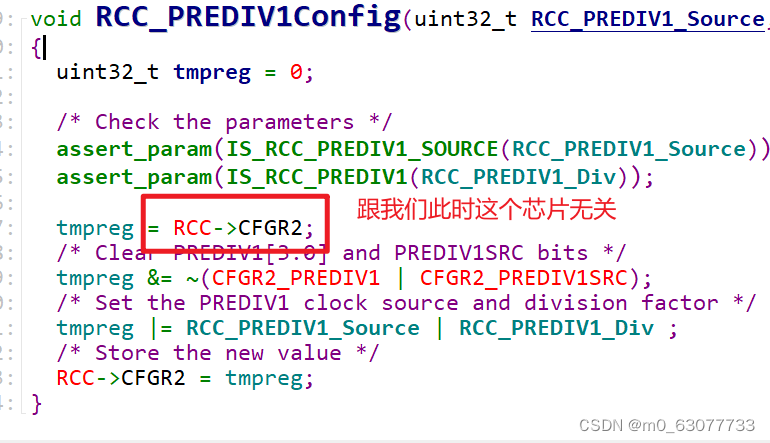
7.RCC_AHBPeriphClockCmd(外设时钟复位)
外设复位

/*** @brief Enables or disables the AHB peripheral clock.* @param RCC_AHBPeriph: specifies the AHB peripheral to gates its clock.* * For @b STM32_Connectivity_line_devices, this parameter can be any combination* of the following values: * @arg RCC_AHBPeriph_DMA1* @arg RCC_AHBPeriph_DMA2* @arg RCC_AHBPeriph_SRAM* @arg RCC_AHBPeriph_FLITF* @arg RCC_AHBPeriph_CRC* @arg RCC_AHBPeriph_OTG_FS * @arg RCC_AHBPeriph_ETH_MAC * @arg RCC_AHBPeriph_ETH_MAC_Tx* @arg RCC_AHBPeriph_ETH_MAC_Rx* * For @b other_STM32_devices, this parameter can be any combination of the * following values: * @arg RCC_AHBPeriph_DMA1* @arg RCC_AHBPeriph_DMA2* @arg RCC_AHBPeriph_SRAM* @arg RCC_AHBPeriph_FLITF* @arg RCC_AHBPeriph_CRC* @arg RCC_AHBPeriph_FSMC* @arg RCC_AHBPeriph_SDIO* * @note SRAM and FLITF clock can be disabled only during sleep mode.* @param NewState: new state of the specified peripheral clock.* This parameter can be: ENABLE or DISABLE.* @retval None*/
void RCC_AHBPeriphClockCmd(uint32_t RCC_AHBPeriph, FunctionalState NewState)
{/* Check the parameters */assert_param(IS_RCC_AHB_PERIPH(RCC_AHBPeriph));assert_param(IS_FUNCTIONAL_STATE(NewState));if (NewState != DISABLE){RCC->AHBENR |= RCC_AHBPeriph;}else{RCC->AHBENR &= ~RCC_AHBPeriph;}
}
8.RCC_HCLKConfig(AHB频率)
配置AHB clock
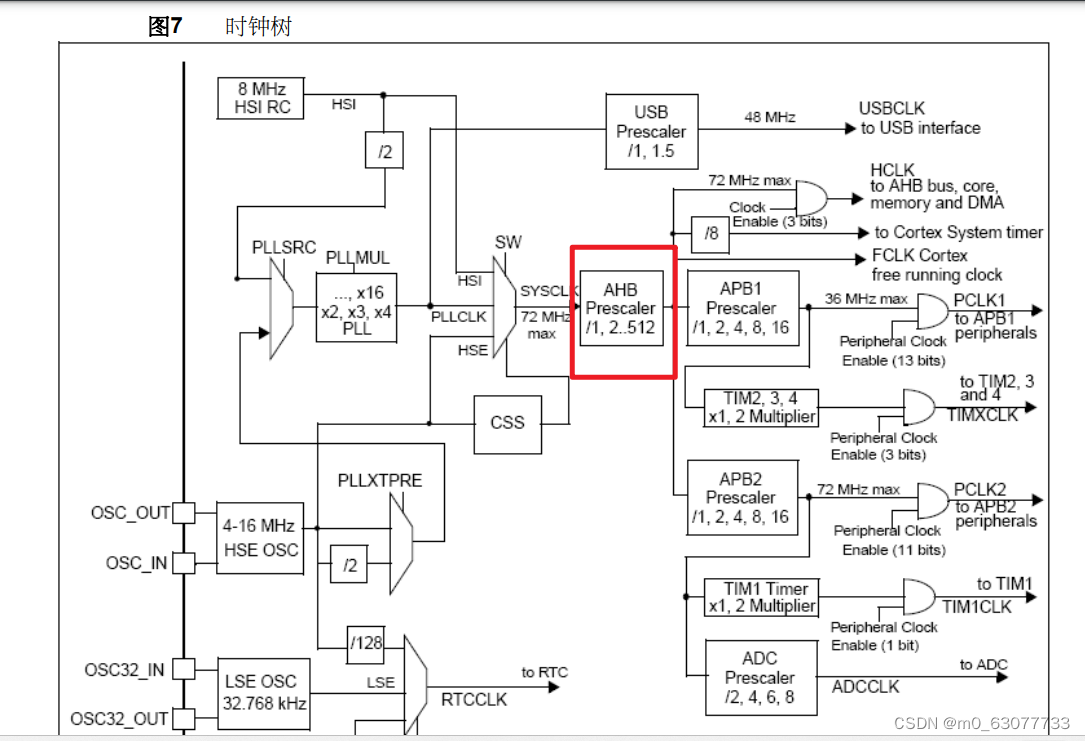
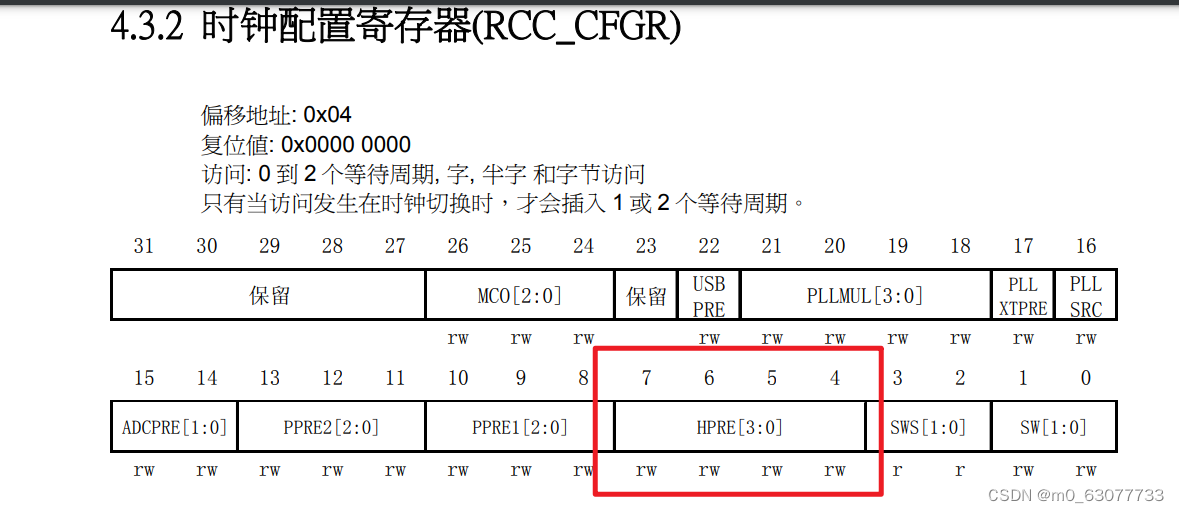
/*** @brief Configures the AHB clock (HCLK).* @param RCC_SYSCLK: defines the AHB clock divider. This clock is derived from * the system clock (SYSCLK).* This parameter can be one of the following values:* @arg RCC_SYSCLK_Div1: AHB clock = SYSCLK* @arg RCC_SYSCLK_Div2: AHB clock = SYSCLK/2* @arg RCC_SYSCLK_Div4: AHB clock = SYSCLK/4* @arg RCC_SYSCLK_Div8: AHB clock = SYSCLK/8* @arg RCC_SYSCLK_Div16: AHB clock = SYSCLK/16* @arg RCC_SYSCLK_Div64: AHB clock = SYSCLK/64* @arg RCC_SYSCLK_Div128: AHB clock = SYSCLK/128* @arg RCC_SYSCLK_Div256: AHB clock = SYSCLK/256* @arg RCC_SYSCLK_Div512: AHB clock = SYSCLK/512* @retval None*/
void RCC_HCLKConfig(uint32_t RCC_SYSCLK)
{uint32_t tmpreg = 0;/* Check the parameters *///判断要进行多少的分频assert_param(IS_RCC_HCLK(RCC_SYSCLK));//选择要进行操纵的寄存器tmpreg = RCC->CFGR;/* Clear HPRE[3:0] bits *//**CFGR_HPRE_Reset_Mask:0xFFFFFF0F==》0000 1111*///表示将CFGR的bit4-bit7位置0tmpreg &= CFGR_HPRE_Reset_Mask;/* Set HPRE[3:0] bits according to RCC_SYSCLK value *///表示将CFGR的bit4-bit7位置1tmpreg |= RCC_SYSCLK;/* Store the new value */RCC->CFGR = tmpreg;
}9.RCC_PCLK1Config(APB1频率)/RCC_PCLK2Config(APB2频率)
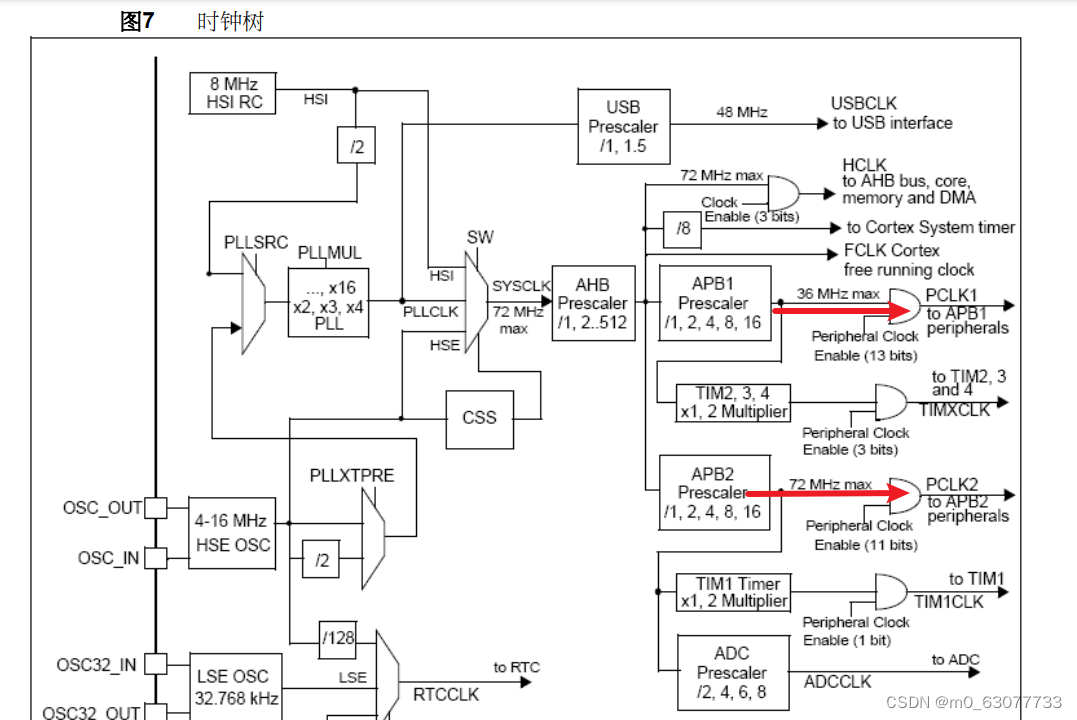
/*** @brief Configures the Low Speed APB clock (PCLK1).* @param RCC_HCLK: defines the APB1 clock divider. This clock is derived from * the AHB clock (HCLK).* This parameter can be one of the following values:* @arg RCC_HCLK_Div1: APB1 clock = HCLK* @arg RCC_HCLK_Div2: APB1 clock = HCLK/2* @arg RCC_HCLK_Div4: APB1 clock = HCLK/4* @arg RCC_HCLK_Div8: APB1 clock = HCLK/8* @arg RCC_HCLK_Div16: APB1 clock = HCLK/16* @retval None*/
void RCC_PCLK1Config(uint32_t RCC_HCLK)
{uint32_t tmpreg = 0;/* Check the parameters */assert_param(IS_RCC_PCLK(RCC_HCLK));tmpreg = RCC->CFGR;/* Clear PPRE1[2:0] bits */tmpreg &= CFGR_PPRE1_Reset_Mask;/* Set PPRE1[2:0] bits according to RCC_HCLK value */tmpreg |= RCC_HCLK;/* Store the new value */RCC->CFGR = tmpreg;
}/*** @brief Configures the High Speed APB clock (PCLK2).* @param RCC_HCLK: defines the APB2 clock divider. This clock is derived from * the AHB clock (HCLK).* This parameter can be one of the following values:* @arg RCC_HCLK_Div1: APB2 clock = HCLK* @arg RCC_HCLK_Div2: APB2 clock = HCLK/2* @arg RCC_HCLK_Div4: APB2 clock = HCLK/4* @arg RCC_HCLK_Div8: APB2 clock = HCLK/8* @arg RCC_HCLK_Div16: APB2 clock = HCLK/16* @retval None*/
void RCC_PCLK2Config(uint32_t RCC_HCLK)
{uint32_t tmpreg = 0;/* Check the parameters */assert_param(IS_RCC_PCLK(RCC_HCLK));tmpreg = RCC->CFGR;/* Clear PPRE2[2:0] bits */tmpreg &= CFGR_PPRE2_Reset_Mask;/* Set PPRE2[2:0] bits according to RCC_HCLK value */tmpreg |= RCC_HCLK << 3;/* Store the new value */RCC->CFGR = tmpreg;
}10.RCC_SYSCLKConfig(选择使用哪一个作为系统时钟HSI/HSE/SYS)

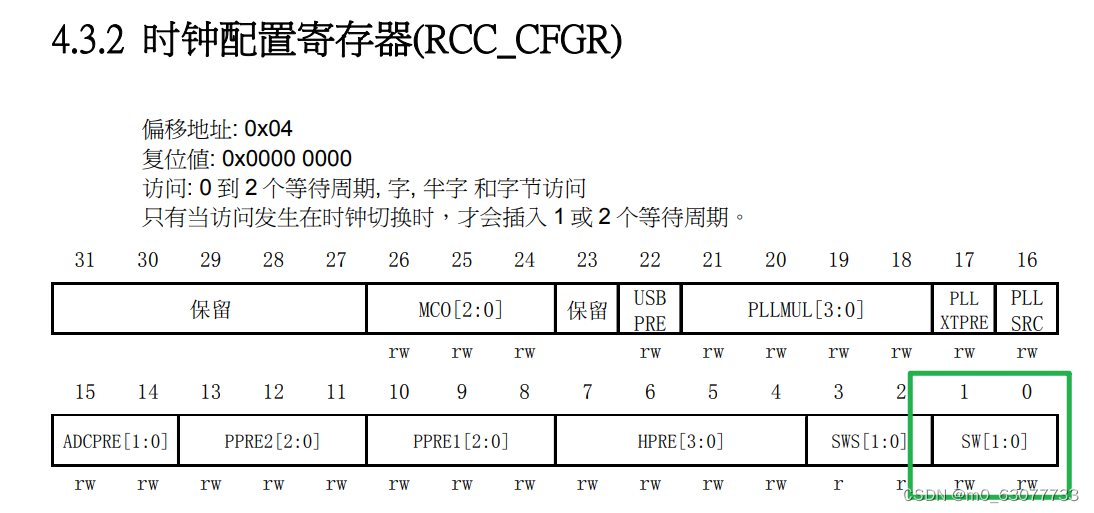

/*** @brief Configures the system clock (SYSCLK).* @param RCC_SYSCLKSource: specifies the clock source used as system clock.* This parameter can be one of the following values:* @arg RCC_SYSCLKSource_HSI: HSI selected as system clock* @arg RCC_SYSCLKSource_HSE: HSE selected as system clock* @arg RCC_SYSCLKSource_PLLCLK: PLL selected as system clock* @retval None*/
void RCC_SYSCLKConfig(uint32_t RCC_SYSCLKSource)
{uint32_t tmpreg = 0;/* Check the parameters *///判断用户输入的参数是否正确assert_param(IS_RCC_SYSCLK_SOURCE(RCC_SYSCLKSource));tmpreg = RCC->CFGR;/* Clear SW[1:0] bits */tmpreg &= CFGR_SW_Mask;//置0/* Set SW[1:0] bits according to RCC_SYSCLKSource value */tmpreg |= RCC_SYSCLKSource;//置1/* Store the new value */RCC->CFGR = tmpreg;
}11.RCC_APB2PeriphResetCmd(外设的重新复位)
/*** @brief Forces or releases High Speed APB (APB2) peripheral reset.* @param RCC_APB2Periph: specifies the APB2 peripheral to reset.* This parameter can be any combination of the following values:* @arg RCC_APB2Periph_AFIO, RCC_APB2Periph_GPIOA, RCC_APB2Periph_GPIOB,* RCC_APB2Periph_GPIOC, RCC_APB2Periph_GPIOD, RCC_APB2Periph_GPIOE,* RCC_APB2Periph_GPIOF, RCC_APB2Periph_GPIOG, RCC_APB2Periph_ADC1,* RCC_APB2Periph_ADC2, RCC_APB2Periph_TIM1, RCC_APB2Periph_SPI1,* RCC_APB2Periph_TIM8, RCC_APB2Periph_USART1, RCC_APB2Periph_ADC3,* RCC_APB2Periph_TIM15, RCC_APB2Periph_TIM16, RCC_APB2Periph_TIM17,* RCC_APB2Periph_TIM9, RCC_APB2Periph_TIM10, RCC_APB2Periph_TIM11 * @param NewState: new state of the specified peripheral reset.* This parameter can be: ENABLE or DISABLE.* @retval None*/
void RCC_APB2PeriphResetCmd(uint32_t RCC_APB2Periph, FunctionalState NewState)
{/* Check the parameters */assert_param(IS_RCC_APB2_PERIPH(RCC_APB2Periph));assert_param(IS_FUNCTIONAL_STATE(NewState));if (NewState != DISABLE){RCC->APB2RSTR |= RCC_APB2Periph;}else{RCC->APB2RSTR &= ~RCC_APB2Periph;}
}4.注意点:
1.进制问题
我们在寄存器中的偏移量都是以十进制进行设置的,如果想要将其定义在宏定义中,记得将其转换为十六进制
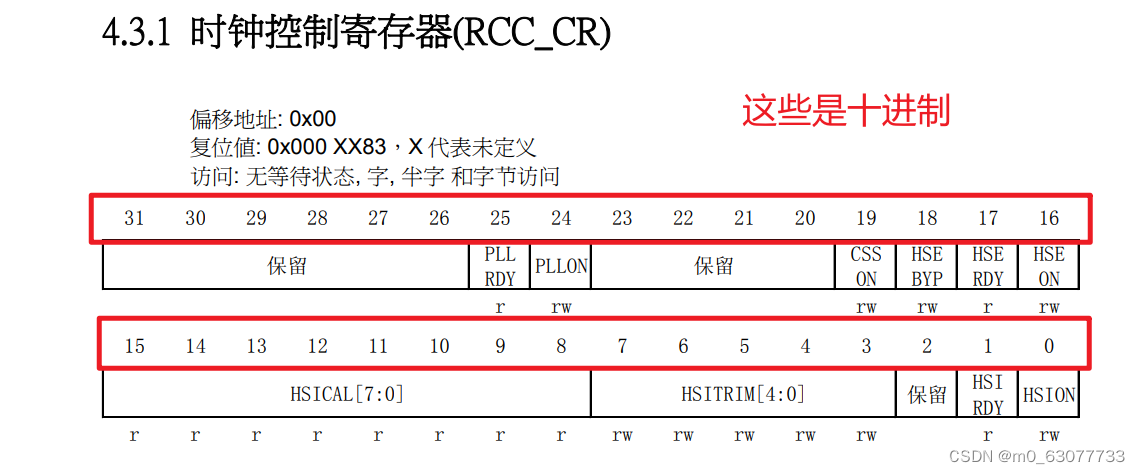
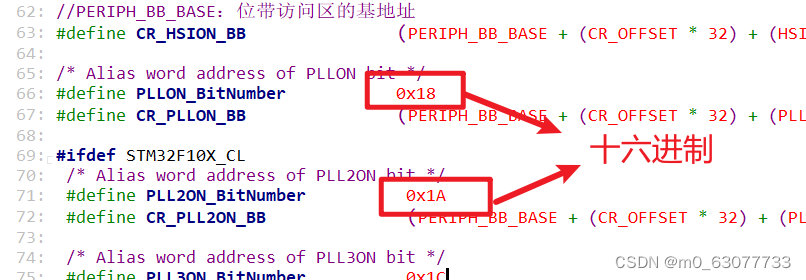
2.位段计算
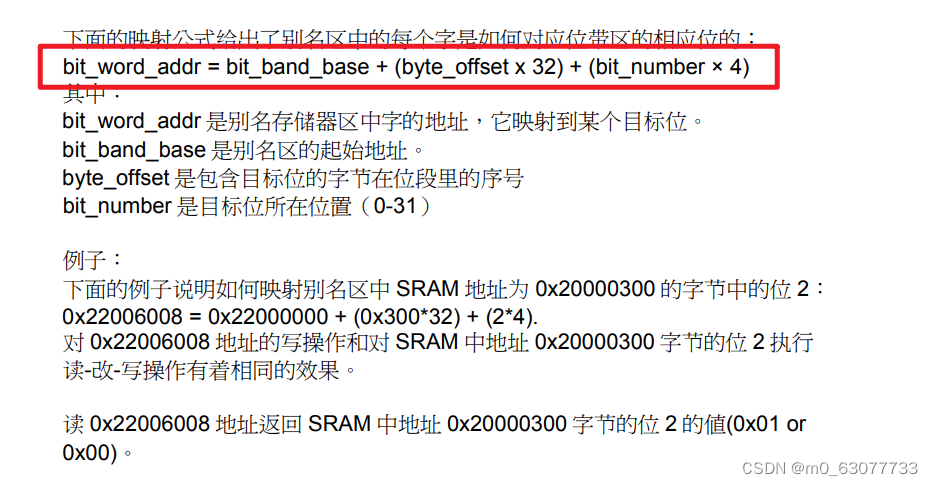
5.使用库重写时钟设置函数
1.原始函数
#include "clock.h"
#include "gpio.h"void Set_SysClockTo72M(void){//检测外部晶振是否准备好unsigned int Rcc_CR_HSE_Ready=0;//等待开启PLL开启成功unsigned int Rcc_CR_PLL_Ready=0;//判断切换成PLL是否成功unsigned int RCC_CF_SWS_PLL=0;unsigned int faultTime=0;//判断等待是否超时//一、复位RCC_CR寄存器rRCC_CR = 0x00000083;//二、开启外部时钟(外部晶振)//第一步:先置0【将bit16清零】rRCC_CR &= ~(1<<16);//关闭HSEON//第二步:在置1rRCC_CR |= (1<<16);//打开HSEON,让HSE开始工作//三、检测外部时钟开启是否成功do{//检测HSEREAY(bit17)是否为1,1表示准备好Rcc_CR_HSE_Ready=rRCC_CR&(1<<17);//取出bit17faultTime++;}while((faultTime<0x0fffffff) && (Rcc_CR_HSE_Ready==0));//跳出do-while 1)要么超时2)要么准好了//判断是超时还是准备好//注意点:不能直接使用“Rcc_CR_HSE_Ready”因为rRCC_CR是需要读一次寄存器//但是读出的结果可能还未改变,所以一定不能直接使用if((rRCC_CR&(1<<17))!=0)//rRCC_CR&(1<<17)==1{//这里HSE就ready,下面再去配置PLL并且等待他ready//设置FlashrFLASH_ACR |= 0x10;rFLASH_ACR &= (~0x03);rFLASH_ACR |= (0x02);//四、对其进行预分频//HPRE【AHB】:对应bit4-bit7:不分频(000)//PPRE1【APB1】:对应bit8-bit10:进行二分频(100)//PPRE2【APB2】:对应bit11-bit13:不分频(000)//AHB和APB2未分频,APB1被2分频//所以最终:AHB和APB2都是72MHZ,APB1是36MHZ//第一步:先置0rRCC_CFGR &=(~((0x0f<<4) | (0x07<<8) | (0x07<<11)));//等价于:rRCC_CFGR=(~(0x3ff<<4));//第二步:置1rRCC_CFGR |=((0x0<<4) | (0x04<<8) | (0x0<<11));//五、设置SHE为输入时钟,同时HSE不分频//选择HSE作为PLL输入并且HSE不分频//设置为输入时钟:bit16//设置为不分频:bit17//第一步:先置0rRCC_CFGR &=(~((1<<16) | (1<<17)));//第二步:置1,bit16rRCC_CFGR |= ((1<<16) | (0<<17));//六、设置PLL倍频系数//9分频:0111:0x07rRCC_CFGR &=(~(0x0f<<18));//清零bit18-bit21rRCC_CFGR |= (0x07<<18);//设置为9倍频//七、打开PLL开关rRCC_CR |= (1<<24);//八、等待开启PLL开启成功//因为前面已经使用到,被累加了,使用这里要重新置0faultTime=0;do{led_init();Rcc_CR_PLL_Ready=rRCC_CR & (1<<25);//检测第25位是否为1faultTime++;}while((faultTime<0x0fffffff) && (Rcc_CR_PLL_Ready==0));if((rRCC_CR & (1<<25)) == (1<<25)){//到这里说明PLL已经稳定,可以用了,下面可以切换成外部时钟了//九、切换成PLLrRCC_CFGR &=(~(0x03)<<0);rRCC_CFGR |=(0x02<<0);//十、判断切换成PLL是否成功//因为前面已经使用到,被累加了,使用这里要重新置0faultTime=0;do{RCC_CF_SWS_PLL=rRCC_CFGR & (0x03<<2);//读出bit2-bit3faultTime++;led_init();//0x02<<2:表示此时转换成PLL}while ((faultTime<0x0FFFFFFF) && (RCC_CF_SWS_PLL!=(0x02<<2)));//十一、此时PLL转换成功if((rRCC_CFGR & (0x03<<2))==(0x02<<2)){//到这里我们的时钟整个就设置好了,可以结束了}else{//到这里说明PLL输出作为PLL失败while(1);}}else{//到这里说明PLL启动时出错了,PLL不能稳定工作while(1);}}else{//超时,或者未准备好,此时HSE不可以使用while(1);}}2.自己封装一个RCC_WaitForPLLStartUp
此处我们参考【RCC_WaitForHSEStartUp】这个函数来自己写
由源文件中没有定义【PLL_STARTUP_TIMEOUT】所以我们要自定义
#define PLL_STARTUP_TIMEOUT ((uint16_t)0x0500000)//本函数作用:等待PLL倍频后输出稳定
//返回值:SUCCESS说明未超时,ERROR超时
ErrorStatus RCC_WaitForPLLStartUp(void)
{__IO uint32_t StartUpCounter = 0;ErrorStatus status = ERROR;FlagStatus PLLStatus = RESET;/* Wait till HSE is ready and if Time out is reached exit */do{//读取寄存器的值PLLStatus = RCC_GetFlagStatus(RCC_FLAG_PLLRDY);StartUpCounter++; //读取是否超时的} while((StartUpCounter != PLL_STARTUP_TIMEOUT) && (PLLStatus == RESET));//这里判断是防止超时if (RCC_GetFlagStatus(RCC_FLAG_PLLRDY) != RESET){status = SUCCESS;}else{//超时status = ERROR;} return (status);
}3.完整使用库函数的clock
//这个函数里面包含了全部外设头文件
#include "stm32f10x.h"
//等价于
//#include"stm32f10x_conf.h"#define PLL_STARTUP_TIMEOUT ((uint16_t)0x0500000)//本函数作用:等待PLL倍频后输出稳定
//返回值:SUCCESS说明未超时,ERROR超时
ErrorStatus RCC_WaitForPLLStartUp(void)
{__IO uint32_t StartUpCounter = 0;ErrorStatus status = ERROR;FlagStatus PLLStatus = RESET;/* Wait till HSE is ready and if Time out is reached exit */do{//读取寄存器的值PLLStatus = RCC_GetFlagStatus(RCC_FLAG_PLLRDY);StartUpCounter++; //读取是否超时的} while((StartUpCounter != PLL_STARTUP_TIMEOUT) && (PLLStatus == RESET));//这里判断是防止超时if (RCC_GetFlagStatus(RCC_FLAG_PLLRDY) != RESET){status = SUCCESS;}else{//超时status = ERROR;} return (status);
}void Set_SysClockTo72M(void){//接收判断回来的HSE是否已经稳定ErrorStatus sta=ERROR;//faultTime:用来判断是否超时unsigned int faultTime=0;unsigned int RCC_CF_SWS_PLL=0;//一、先关闭HSEON然后在打开HSEONRCC_HSEConfig(RCC_HSE_ON);/*rRCC_CR = 0x00000083;rRCC_CR &= ~(1<<16);//关闭HSEONrRCC_CR |= (1<<16);//打开HSEON,让HSE开始工作*///二、等到HSE稳定sta=RCC_WaitForHSEStartUp();/*do{//检测HSEREAY(bit17)是否为1,1表示准备好Rcc_CR_HSE_Ready=rRCC_CR&(1<<17);//取出bit17faultTime++;}while((faultTime<0x0fffffff) && (Rcc_CR_HSE_Ready==0));//跳出do-while 1)要么超时2)要么准好了*///三、判断是HSE稳定了还是超时了if(sta==SUCCESS)//if((rRCC_CR&(1<<17))!=0)//rRCC_CR&(1<<17)==1{//这里HSE就ready,下面再去配置PLL并且等待他ready//四、设置FlashFLASH->ACR |= 0x10;FLASH->ACR &= (~0x03);FLASH->ACR |= (0x02);/*rFLASH_ACR |= 0x10;rFLASH_ACR &= (~0x03);rFLASH_ACR |= (0x02);*///AHB和APB2未分频,APB1被2分频//所以最终:AHB和APB2都是72MHZ,APB1是36MHZ//五、配置相关的倍频信息//配置HCLK为SYSCLK/1RCC_HCLKConfig(RCC_SYSCLK_Div1);//配置PCLK1为JCLK的2分频RCC_PCLK1Config(RCC_HCLK_Div2);//配置PCLK2为JCLK的1分频RCC_PCLK2Config(RCC_HCLK_Div1);/*rRCC_CFGR &=(~((0x0f<<4) | (0x07<<8) | (0x07<<11)));//等价于:rRCC_CFGR=(~(0x3ff<<4));rRCC_CFGR |=((0x0<<4) | (0x04<<8) | (0x0<<11));*///六、设置HSE/1为PLL时钟源,PLL倍频系数为9RCC_PLLConfig(RCC_PLLSource_HSE_Div1,RCC_PLLMul_9);/*//设置SHE为输入时钟,同时HSE不分频rRCC_CFGR &=(~((1<<16) | (1<<17)));rRCC_CFGR |= ((1<<16) | (0<<17));//设置PLL倍频系数//9分频:0111:0x07rRCC_CFGR &=(~(0x0f<<18));//清零bit18-bit21rRCC_CFGR |= (0x07<<18);//设置为9倍频*///七、打开PLL开关RCC_PLLCmd(ENABLE);//rRCC_CR |= (1<<24);//因为HAL库中没有等到PLL的函数//此处我们参考【RCC_WaitForHSEStartUp】这个函数来自己写//八、等待开启PLL开启成功sta=RCC_WaitForPLLStartUp();/*//因为前面已经使用到,被累加了,使用这里要重新置0faultTime=0;do{led_init();Rcc_CR_PLL_Ready=rRCC_CR & (1<<25);//检测第25位是否为1faultTime++;}while((faultTime<0x0fffffff) && (Rcc_CR_PLL_Ready==0));*///九、判断PLL稳定还是超时//if((rRCC_CR & (1<<25)) == (1<<25)){if(sta==SUCCESS){//到这里说明PLL已经稳定,可以用了,下面可以切换成外部时钟了//九、切换成PLLRCC_SYSCLKConfig(RCC_SYSCLKSource_PLLCLK);/*rRCC_CFGR &=(~(0x03)<<0);rRCC_CFGR |=(0x02<<0);*/ //十、判断切换成PLL是否成功//因为前面已经使用到,被累加了,使用这里要重新置0faultTime=0;do{RCC_CF_SWS_PLL=RCC->CFGR & (0x03<<2);//读出bit2-bit3faultTime++;//0x02<<2:表示此时转换成PLL}while ((faultTime<0x0FFFFFFF) && (RCC_CF_SWS_PLL!=(0x02<<2)));//十一、此时PLL转换成功if((RCC->CFGR & (0x03<<2))==(0x02<<2)){//到这里我们的时钟整个就设置好了,可以结束了}else{//到这里说明PLL输出作为PLL失败while(1);}}else{//到这里说明PLL启动时出错了,PLL不能稳定工作while(1);}}else{//超时,或者未准备好,此时HSE不可以使用while(1);}}6.SystmInit注意点:
我们在“startup_stm32f10x_md.s”文件中可以看到在执行main函数之前会先执行一个“SystemInit”函数
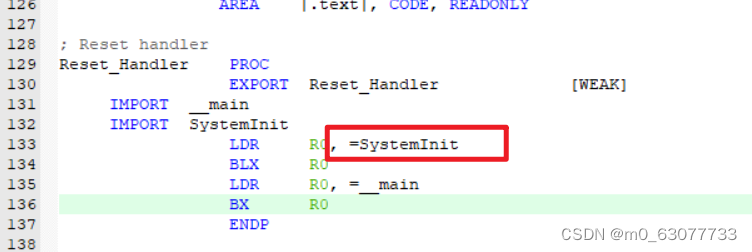

所以如果我们想要使用自己的设置72MHZ频率的函数,则应该将SystemInit注释调。
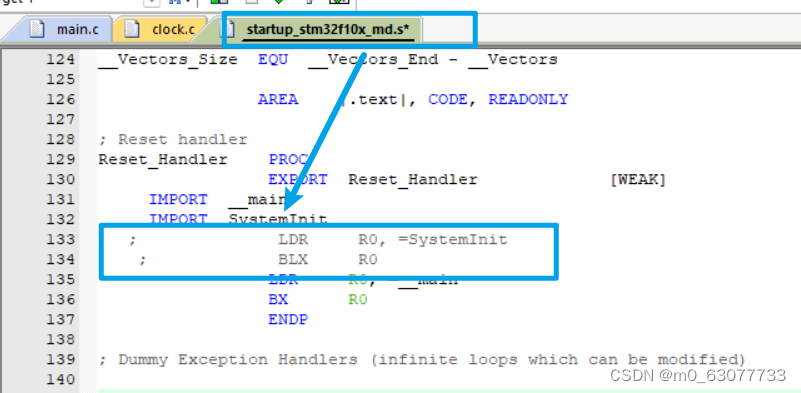
相关文章:

【STM32】RCC时钟模块(使用HAL库)
https://gitee.com/linhir-linhir/stm32-f103-c8/blob/master/STM32%E6%9C%80%E6%96%B0%E5%9B%BA%E4%BB%B6%E5%BA%93v3.5/Libraries/STM32F10x_StdPeriph_Driver/inc/stm32f10x_rcc.h STM32最新固件库v3.5/Libraries/CMSIS/CM3/DeviceSupport/ST/STM32F10x/system_stm32f10x.c…...

WPF中的绑定知识详解(含案例源码分享)
✅作者简介:2022年博客新星 第八。热爱国学的Java后端开发者,修心和技术同步精进。 🍎个人主页:Java Fans的博客 🍊个人信条:不迁怒,不贰过。小知识,大智慧。 💞当前专栏…...
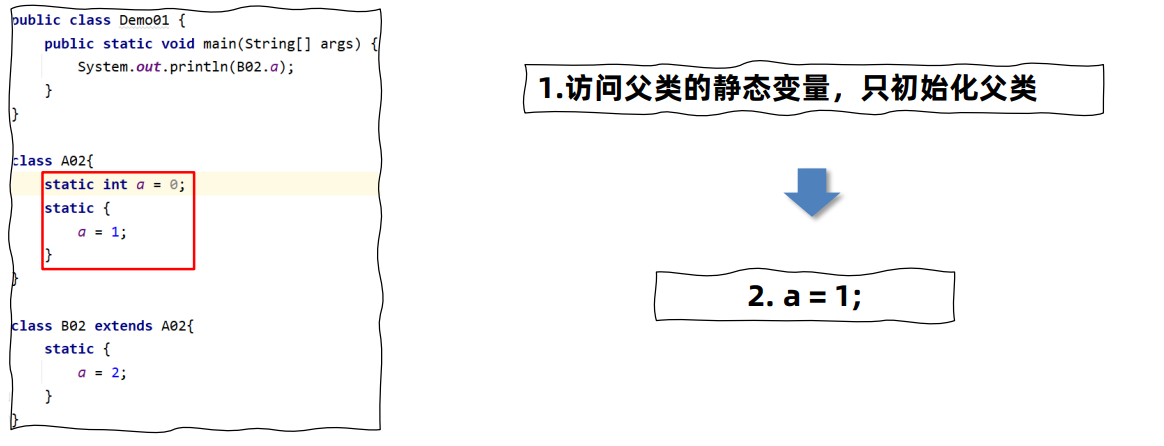
【JVM】类的生命周期
【JVM】类的生命周期 文章目录 【JVM】类的生命周期1. 生命周期概述2. 加载阶段3. 连接阶段3.1 验证3.2 准备3.3 解析 4. 初始化阶段4.1 触发初始化的方式4.2 clinit不存在的情况4.3 多个类的初始化 5. 总结 1. 生命周期概述 类的生命周期分为5/7个阶段: 加载(Loa…...

asp.net网上商城系统VS开发sqlserver数据库web结构c#编程Microsoft Visual Studio协同过滤设计
一、源码特点 asp.net网上商城系统是一套完善的web设计管理系统系统采用协同过滤算法进行商品推荐,系统具有完整的源代码和数据库,系统主要采用B/S模式开发。开发环境为vs2010,数据库 为sqlserver2008,使用c#语言开发 ASP…...

APUS入驻百度灵境矩阵,普惠AI大模型插件能力
10月17日,APUS出席百度世界大会2023。会上,百度公布了灵境矩阵业务进展,APUS作为灵境矩阵首批合作伙伴正与百度携手拓展大模型能力边界、构建大模型应用生态。 百度认为,大模型将繁荣AI应用生态,在生态搭建过程中&…...

通过C++调用Com接口
头文件 #include <iostream> #include <Windows.h> #include <comdef.h> #include <rpcdce.h> using namespace std; #pragma comment(lib, "Rpcrt4.lib")72C24DD5-D70A-438B-8A42-98424B88AFB8 通过Wscript.Shell来创建进程: void Wscri…...

完全背包问题
目录 1. 朴素解法 2. 优化 原题链接: 3. 完全背包问题 - AcWing题库 题目描述: 有 N 种物品和一个容量是 V 的背包,每种物品都有无限件可用。 第 i 种物品的体积是 vi,价值是 wi。 求解将哪些物品装入背包,可使这些…...

J2EE的N层体系结构
J2EE平台采用了多层分布式应用程序模型,实现不同逻辑功能的应用程序被封装到不同的构件中,处于不同层次的构件可被分别部署到不同的机器中。 RMI/IIOP:RMI(Remote Method Invocation,远程方法调用)是Java的…...

Quirks(怪癖)模式是什么?它和 Standards(标准)模式有什么区别?
目录 前言: 用法: 代码: Quirks模式示例: Standards模式示例: 理解: Quirks模式: Standards模式: 高质量讨论: 前言: "Quirks模式"和"Standards模式"是与HTML文档渲染模式相关的两种模式。它们影响着浏览器如何解释和渲染HT…...
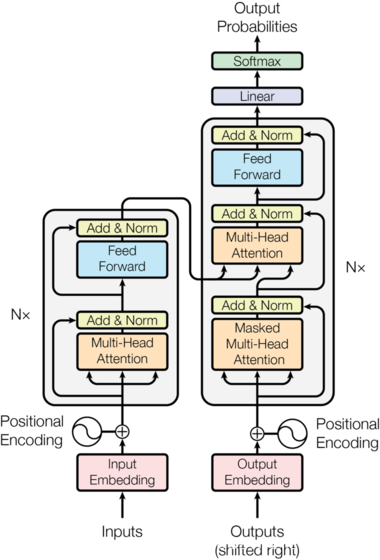
自然语言处理---Transformer模型
Transformer概述 相比LSTM和GRU模型,Transformer模型有两个显著的优势: Transformer能够利用分布式GPU进行并行训练,提升模型训练效率。 在分析预测更长的文本时,捕捉间隔较长的语义关联效果更好。 Transformer模型的作用 基于seq…...

动画系统的前世今生(一)
掐指一算,五年没更新过我的CSDN账号啦,方向也从人工智能变成了计算机图形学,当然也依旧会关注AI的发展,之前在知乎上写了一些文章[传送门],后续也会逐渐同步到CSDN上~ 这个系列将包含五篇文章,内…...

11 结构型模式- 代理模式
结构性模式一共包括七种: 代理模式、桥接模式、装饰者模式、适配器模式、门面(外观)模式、组合模式、和享元模式。 1 代理模式介绍 软件开发中的代理: 代理模式中引入了一个新的代理对象,代理对象在客户端对象和目标对象之间起到了中介的作用,它去掉客…...
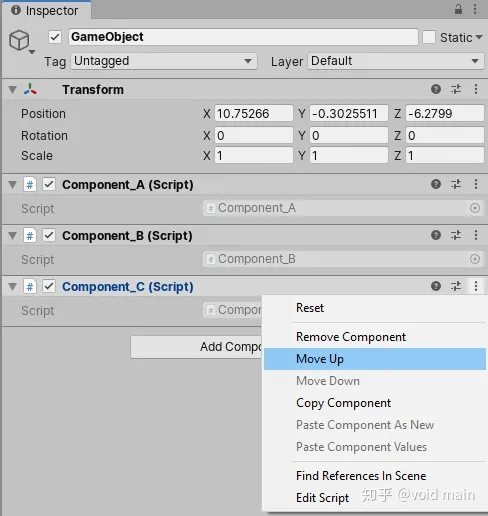
Unity--用户界面
目录 “使用工具栏”: “层次结构”窗口: 层次结构窗口 制作子GameObject “游戏”视图: “场景视图“: ”项目窗口“: 项目窗口工具栏: "Inspector" 窗口: Inspector 游戏…...

BUUCTF 乌镇峰会种图 1
BUUCTF:https://buuoj.cn/challenges 题目描述: 乌镇互联网大会召开了,各国巨头汇聚一堂,他们的照片里隐藏着什么信息呢?(答案格式:flag{答案},只需提交答案࿰…...

Runner GoUI自动化测试发布
构建自动化测试体系是当下每个项目团队愿意去做的,自动化测试减少重复操作节省人力成本。 RunnerGo UI自动化平台 RunnerGo提供从API管理到API性能再到可视化的API自动化、UI自动化测试功能模块,覆盖了整个产品测试周期。 RunnerGo UI自动化基于Selen…...

【Gensim概念】03/3 NLP玩转 word2vec
第三部分 对象函数 八 word2vec对象函数 该对象本质上包含单词和嵌入之间的映射。训练后,可以直接使用它以各种方式查询这些嵌入。有关示例,请参阅模块级别文档字符串。 类型 KeyedVectors 1) add_lifecycle_event(event_name, log_level2…...

【网络协议】聊聊网络路由相关算法
如何配置路由 路由器是一台网络设备,多张网卡,当一个入口的网络包到达路由器时,会根据本地的信息库决定如何正确的转发流量,通常称为路由表 路由表主要包含如下 核心思想是根据目的 IP 地址来配置路由 目的网络:要去…...
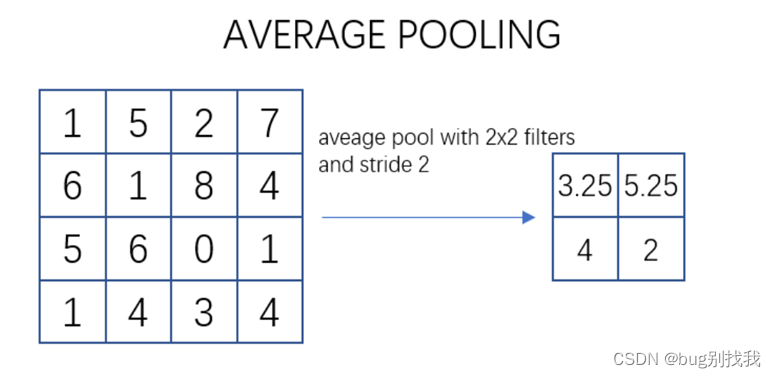
Python 深度学习入门之CNN
CNN 前言一、CNN简介1、简介2、结构 二、CNN简介1、输出层2、卷积层3、池化层4、全连接层5、输出层 前言 1024快乐!1024快乐!今天开新坑,学点深度学习相关的,说下比较火的CNN。 一、CNN简介 1、简介 CNN的全称是Convolutiona…...

国产开发板上打造开源ThingsBoard工业网关--基于米尔芯驰MYD-JD9X开发板
本篇测评由面包板论坛的优秀测评者“JerryZhen”提供。 本文将介绍基于米尔电子MYD-JD9X开发板打造成开源的Thingsboard网关。 Thingsboard网关是一个开源的软件网关,采用python作为开发语言,可以部署在任何支持 python 运行环境的主机上,灵…...

英语——语法——从句——名词性从句——笔记
文章目录 名词性从句一、定义二、分类(一)宾语从句(二)主语从句(三)C同位语从句(四)D表语从句 名词性从句 一、句子成分 简而言之,构成一个句子的成分(或要素…...
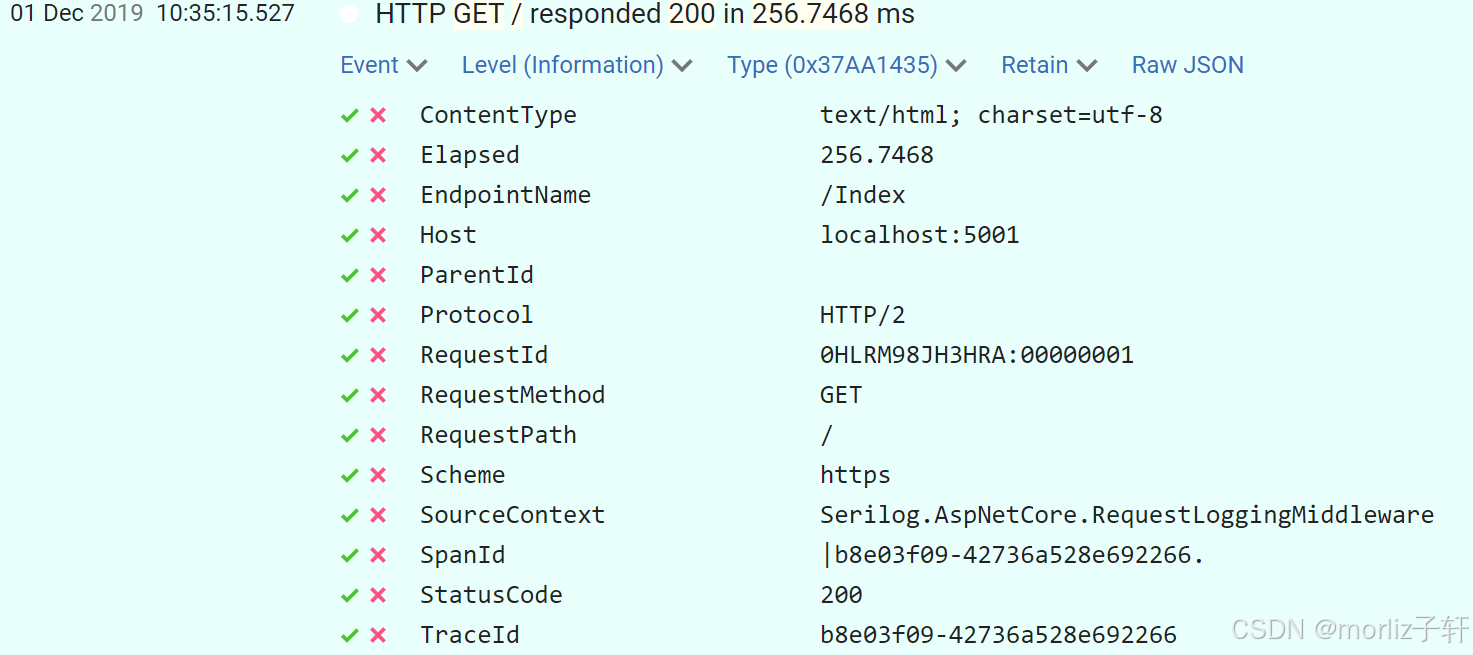
深入浅出Asp.Net Core MVC应用开发系列-AspNetCore中的日志记录
ASP.NET Core 是一个跨平台的开源框架,用于在 Windows、macOS 或 Linux 上生成基于云的新式 Web 应用。 ASP.NET Core 中的日志记录 .NET 通过 ILogger API 支持高性能结构化日志记录,以帮助监视应用程序行为和诊断问题。 可以通过配置不同的记录提供程…...

PHP和Node.js哪个更爽?
先说结论,rust完胜。 php:laravel,swoole,webman,最开始在苏宁的时候写了几年php,当时觉得php真的是世界上最好的语言,因为当初活在舒适圈里,不愿意跳出来,就好比当初活在…...

2025年能源电力系统与流体力学国际会议 (EPSFD 2025)
2025年能源电力系统与流体力学国际会议(EPSFD 2025)将于本年度在美丽的杭州盛大召开。作为全球能源、电力系统以及流体力学领域的顶级盛会,EPSFD 2025旨在为来自世界各地的科学家、工程师和研究人员提供一个展示最新研究成果、分享实践经验及…...

linux 下常用变更-8
1、删除普通用户 查询用户初始UID和GIDls -l /home/ ###家目录中查看UID cat /etc/group ###此文件查看GID删除用户1.编辑文件 /etc/passwd 找到对应的行,YW343:x:0:0::/home/YW343:/bin/bash 2.将标红的位置修改为用户对应初始UID和GID: YW3…...
)
相机Camera日志分析之三十一:高通Camx HAL十种流程基础分析关键字汇总(后续持续更新中)
【关注我,后续持续新增专题博文,谢谢!!!】 上一篇我们讲了:有对最普通的场景进行各个日志注释讲解,但相机场景太多,日志差异也巨大。后面将展示各种场景下的日志。 通过notepad++打开场景下的日志,通过下列分类关键字搜索,即可清晰的分析不同场景的相机运行流程差异…...

全面解析各类VPN技术:GRE、IPsec、L2TP、SSL与MPLS VPN对比
目录 引言 VPN技术概述 GRE VPN 3.1 GRE封装结构 3.2 GRE的应用场景 GRE over IPsec 4.1 GRE over IPsec封装结构 4.2 为什么使用GRE over IPsec? IPsec VPN 5.1 IPsec传输模式(Transport Mode) 5.2 IPsec隧道模式(Tunne…...
Reasoning over Uncertain Text by Generative Large Language Models
https://ojs.aaai.org/index.php/AAAI/article/view/34674/36829https://ojs.aaai.org/index.php/AAAI/article/view/34674/36829 1. 概述 文本中的不确定性在许多语境中传达,从日常对话到特定领域的文档(例如医学文档)(Heritage 2013;Landmark、Gulbrandsen 和 Svenevei…...

【生成模型】视频生成论文调研
工作清单 上游应用方向:控制、速度、时长、高动态、多主体驱动 类型工作基础模型WAN / WAN-VACE / HunyuanVideo控制条件轨迹控制ATI~镜头控制ReCamMaster~多主体驱动Phantom~音频驱动Let Them Talk: Audio-Driven Multi-Person Conversational Video Generation速…...

【Go语言基础【12】】指针:声明、取地址、解引用
文章目录 零、概述:指针 vs. 引用(类比其他语言)一、指针基础概念二、指针声明与初始化三、指针操作符1. &:取地址(拿到内存地址)2. *:解引用(拿到值) 四、空指针&am…...

排序算法总结(C++)
目录 一、稳定性二、排序算法选择、冒泡、插入排序归并排序随机快速排序堆排序基数排序计数排序 三、总结 一、稳定性 排序算法的稳定性是指:同样大小的样本 **(同样大小的数据)**在排序之后不会改变原始的相对次序。 稳定性对基础类型对象…...
